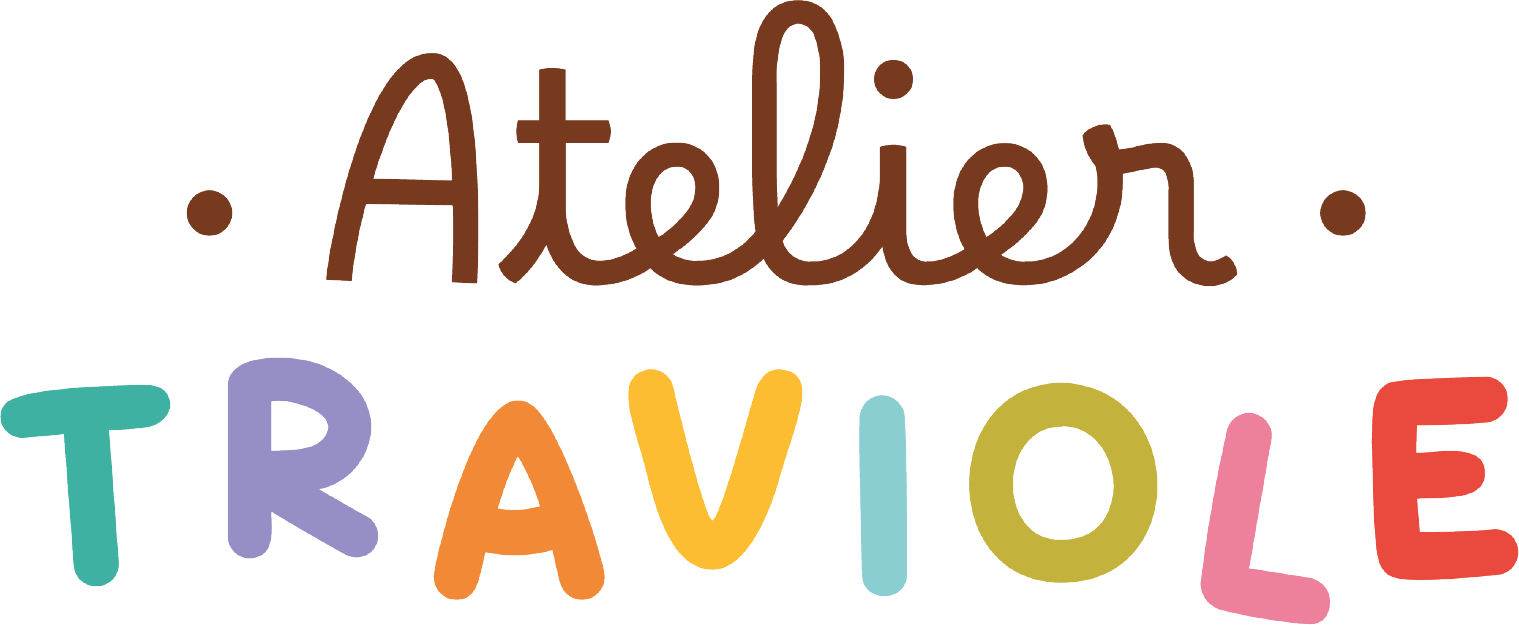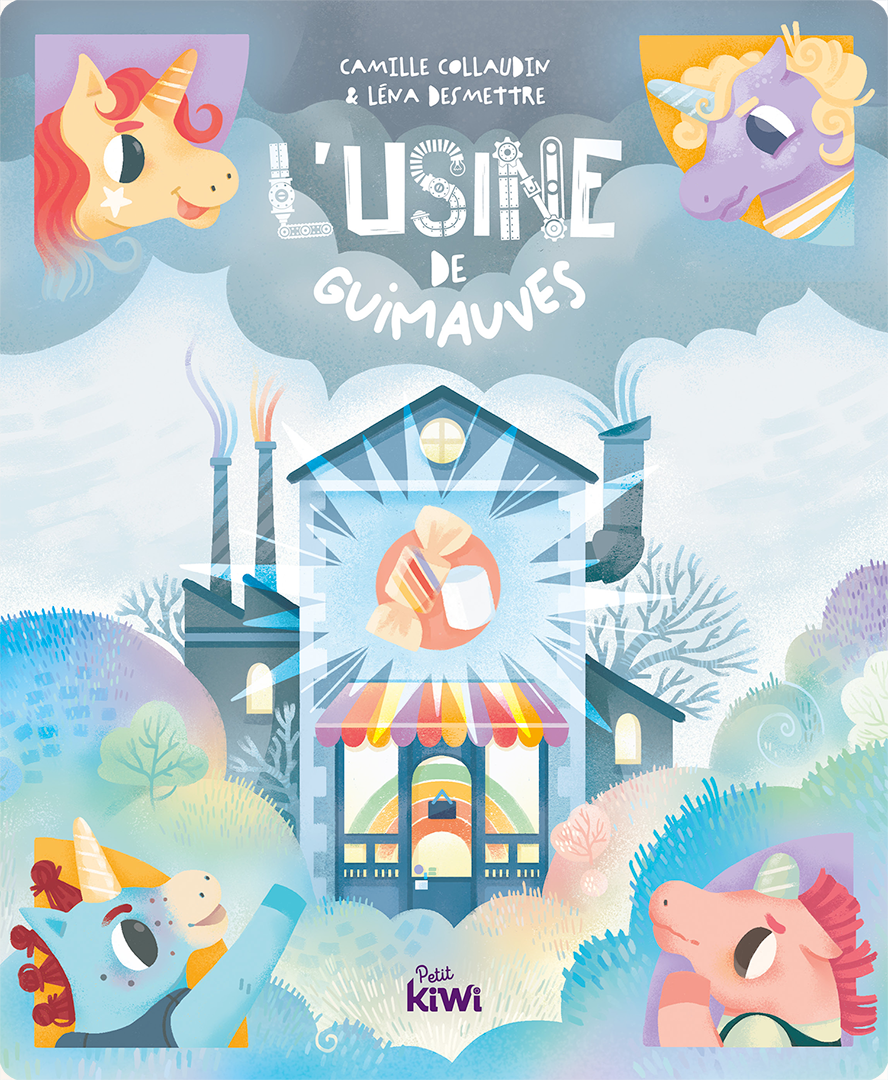L’Usine de guimauves
(French for “The Marshmallow Factory”)
Alice Bellecorne lives in a wonderful cloud village. One day, Mr. Moustachecorne decides to open his marshmallow factory there; very quickly, all the unicorns enjoy these sweets. But they always ask for more! Little by little, Alice and her friends realise that the clouds and rainbows needed to make the marshmallows are getting scarce… Will they manage to find a solution to preserve the village’s resources?
Book available in French in independent bookstores, cultural shops (Fnac, Cultura, Amazon, Espace culturel Leclerc)… In France, Belgium, Switzerland and Canada (Quebec) !
Something I’m very proud of has happened, as you can see from the preface of this article: on October 18, 2022, the first album I ever illustrated entirely, The Marshmallow Factory was released in bookstores. It felt really good to see it in print, and then to see it on the shelf, it was very validating for me, who tends to have an imposter syndrome.
So, as I’ve consumed a lot of content around the book creation process to better understand this angle of the illustrator’s profession (and to make me fantasize). It’s my way of doing my bit for this community of artists.
So let me tell you a little behind-the-scenes story about illustrating this book! 🙂

Negotiation 📝
On 26 January, at 2:14pm, I received an email from Marine Bourasseau (then editor at les Éditions Kiwi/Petit Kiwi, now freelance): she explained the publishing house’s editorial line - engaged books that talk about subjects not often addressed in children’s literature -, and then she pitched the story she saw me illustrating based on my portfolio. My heart skips a beat; she talks about ecology, friendship, unicorns, sugar and colour. I love it..
Then comes the negotiation period, she makes me read the manuscript, shares the budget and the terms of the publishing contract. During this period, our communications are quite formal, we talk about handing over files, copyrights, contract clauses… It’s not necessarily the most fun part of the process but it’s necessary for everyone to be in agreement to start the project.
After signing, I waited for the technical details of the illustrations (size, file format, colour profile, bleed and quiet zone) before starting the second phase of the program.
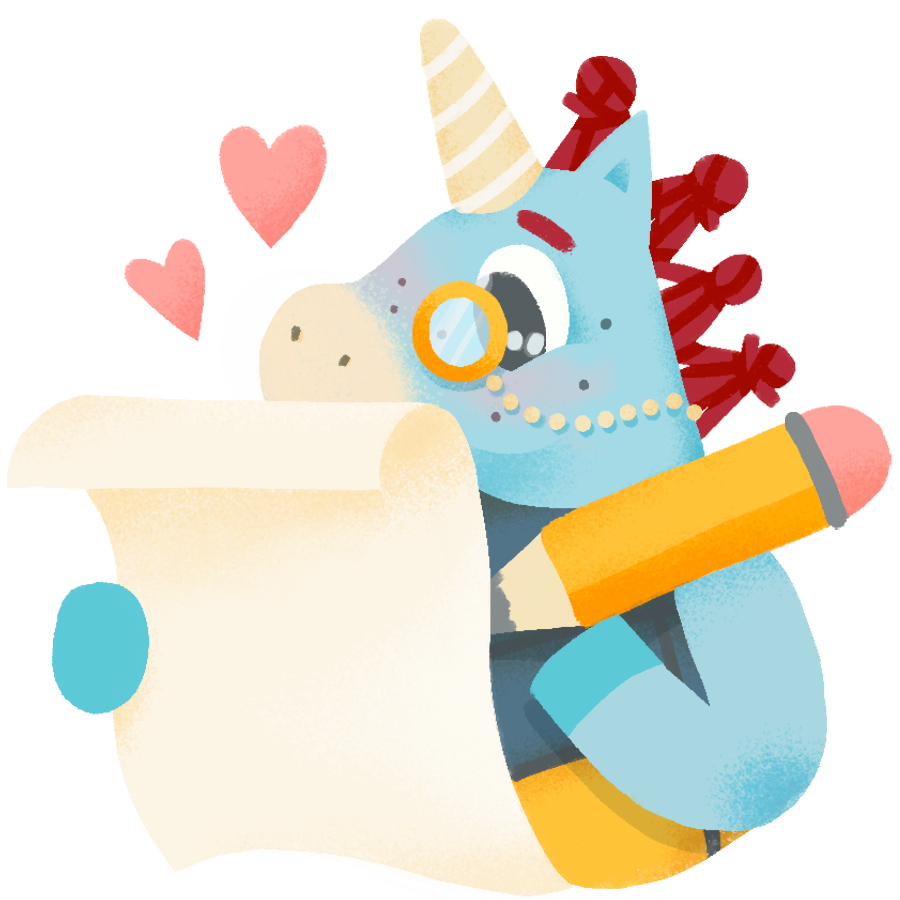
Watch & Preparation 🧭
This stage is hidden, I did it on my own without necessarily talking to the editor who was working with the author, Camille Collaudin, to perfect the text.
This was the period during which I became familiar with the subject of the project. I did a kind of “technology watch”: I looked at what a unicorn looked like in the books that had already been published, how pollution or clouds were represented. At that time, it was important for me to see how the graphic style changed according to the age of the reader. With a text like this, which talks about a serious subject (overconsumption) in a sweet world, I knew I would have to find a balance between vulgarisation and fantasy.
I also used this time to prepare logistically for the upcoming creation: I decided to use Notion to keep the author informed of my progress, I prepared the project page in my bullet journal, and I organised the files on my cloud knowing that they would fill up with colours.
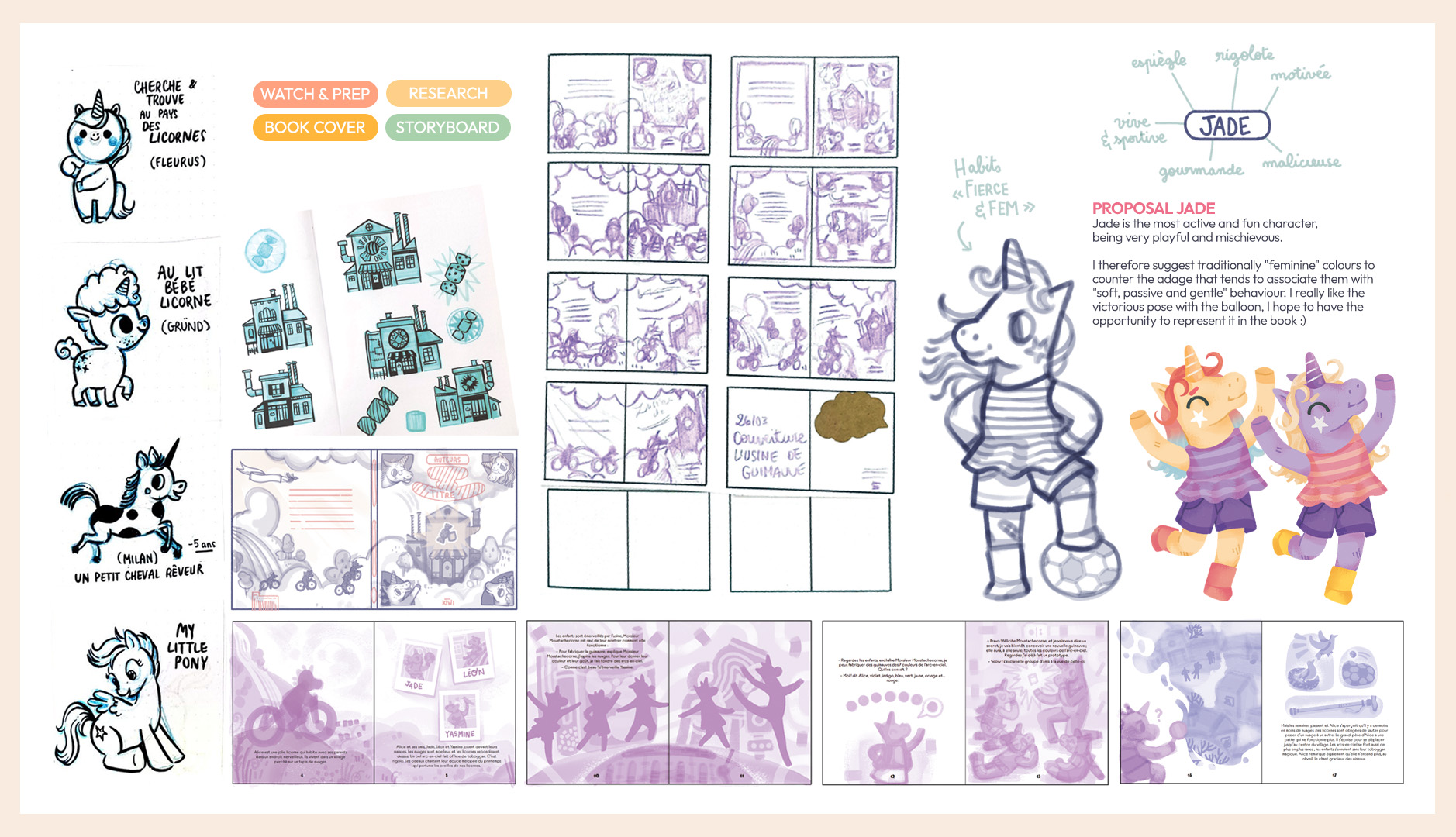
Research 🎨
During a video conference, I met Camille and got to know Marine better, and together we talked about this book. We talked about the aesthetics we imagined, our inspirations, the message we wanted to convey, the backdrop of the story… And I was finally able to pick up the brushes, well, the graphic tablet and the notebooks. The aim was to build the iconographical dictionary of the book.
I asked myself questions like :
- How can you tell a young unicorn from an old one?
- What does a building that contains both a sweet shop and a factory look like?
- What is the personality of the different protagonists? And how does it affect their design?
- What exact colours make up a rainbow in a pastel atmosphere?
I then sketch the context in which the story takes place. I think it’s my love of worldbuilding in role-playing that makes me particularly enjoy this step.

Book cover ⛅
For this particular project, I had to create the cover of the book before I started the pages. This is a fairly common practice in the publishing industry, as it allows the distributor (the company responsible for supplying the book to the various retailers) to have more information about the forthcoming publication.
Storyboard 📔
The object-book becomes a reality when Marine sends me the flat plan (sometimes called a mock-up). This is a document, the actual size of the book, which places the text on the page and shows the space dedicated to the illustration. It is sometimes annotated with instructions, of varying length, on what each image is meant to contain, as was the case here.
A page can be white with only text, it can have an illustration cropped on a white background (spot illustration), the illustration can take up the whole page, with or without a frame, or a full double page.
From this document, I can establish the general composition of the book in a storyboard of thumbnails.
Without dwelling too much on the details, I determine where the element is, what is represented, and I choose whether I follow the railway or take the initiative to make a different proposal. It is thanks to the preliminary steps that I am efficient in composing the book. Of course, I share my progress with the editor and modify according to her feedback. I really see it as a collaboration, we share our visions so that the pages follow a logical sequence.
Sketches ✏️
In the timeline above, you can see that the " Sketches " and " Final illustrations " phases are quite short compared to the rest of the project. In fact, the previous phases did not require as much time commitment as these last ones; we were dealing with an email a day or an hour of research here and there. This is mainly because, during this period, the priority of the publishing house is to polish the text.
However, once the storyboard has been validated, the project fills my entire schedule.
By allocating more hours per day to illustration, I need fewer days to present my work to the editorial team. It is during this stage that the illustrations are filled with small details. To make the mood of each page clear when reading my pencil sketches, I like to annotate them.
Final illustrations 🌈
Finally, my favorite part: the final illustrations. Thanks to the preparation, research and pencils, I don’t have to think much about anything other than the shapes and colours when I draw the final rendering. To make sure the colours and characters stay the same throughout the book, I rely on two documents: the reference sheet where I have compiled research and key points that are likely to be repeated, and the updated storyboard, an A3 page where I paste the finished illustrations in place, so I can see the whole book at a glance.
The choice of colours is really the aspect of my work that I enjoy the most.
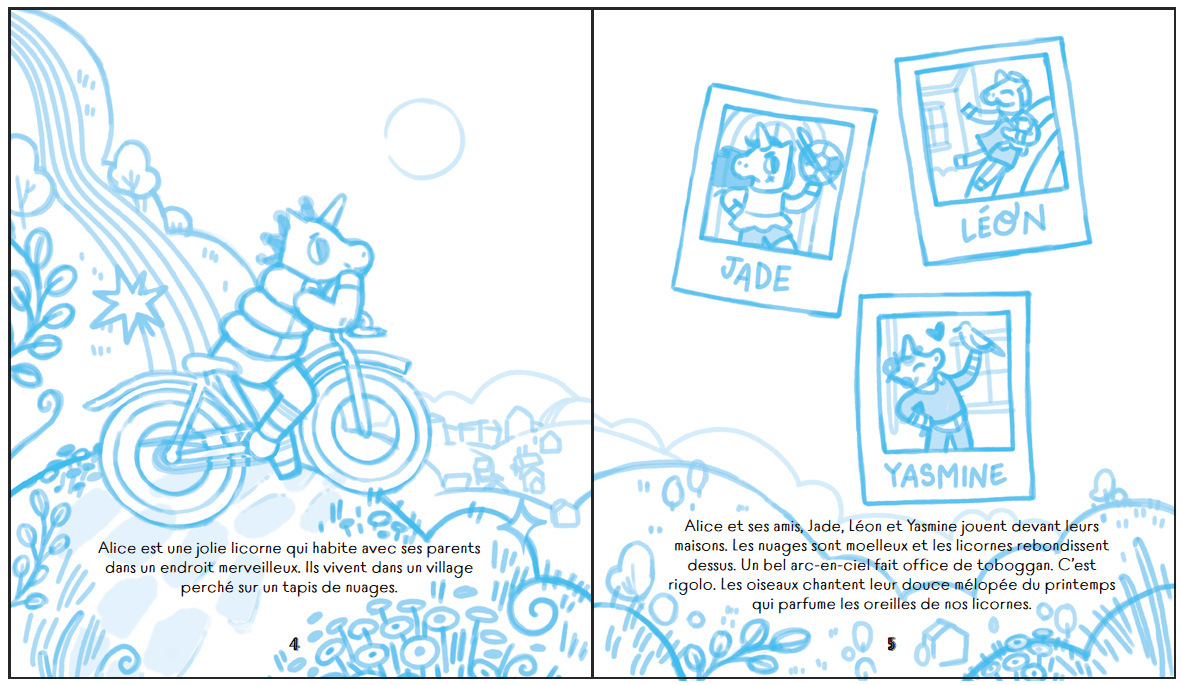
This double page spread is the first in the book.
It introduces the world in which the story takes place (a magical world in the clouds), the main characters (young unicorns), and the general aesthetics of the book (acidulous and multi-coloured).

For this double page spread, the rainbow in the background represents the magic of the place. The characters visit the factory while dancing, as if enchanted by Mr. Moustachecorne…
But they don’t know that he will cause a lot of problems to their environment later on.
Pass for press (or proof) 🎯
The last stage of creation, the final document, with the final texts and the corresponding images, is the print proof. The editor (Anthéa Krebs, then Lucie Bernamont), the author and I, see the book for the first time, mounted by the graphic designer. We made the final adjustments, and the book was ready for the printing process.
So, I’ve told you all about how I illustrated this first children’s book. Between the email introducing the project and the sending of the final illustrations, it took a little less than six months, 125 working days, with a summer break of two months before the validation of the proof.
Today, I have my book in my hands, it has been on the bookshelves for a month, I talk about it in interviews, I receive feedback from readers, and that makes me very proud. But… I don’t intend to stop here! This whole process, with its ups and downs (like the change of editor), makes me realise that I truly love working in children’s publishing. I’m very happy to present this album, and even happier to be doing this job. Now I can’t wait to do the next book to see how my methods change and to have new challenges to overcome!
So, did you enjoy going behind the scenes of this book? 😉
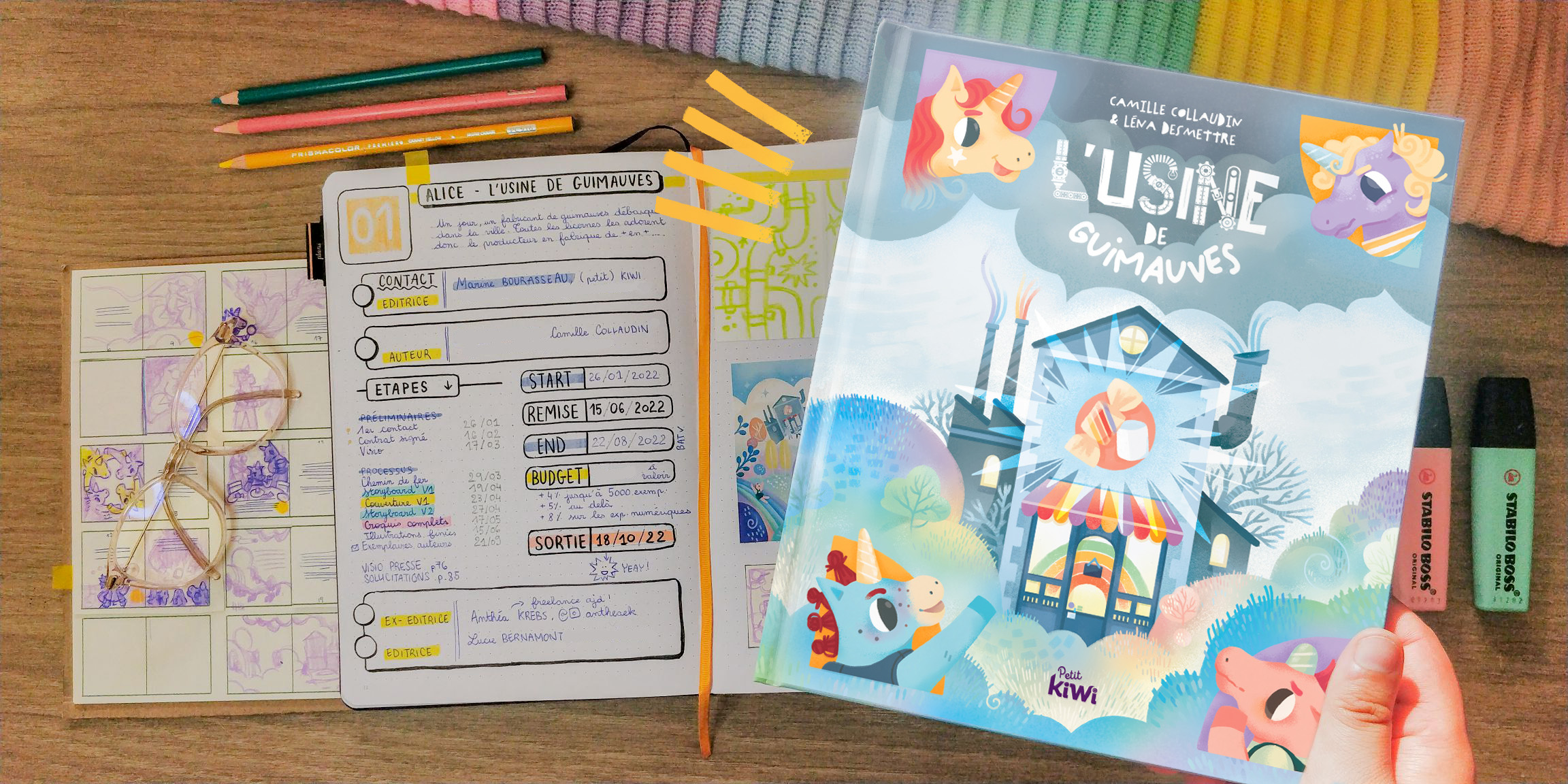
Photo by Léna Desmettre (2022) of the printed book, my Bullet Journal and my handmade composition notebook; since the book came out, it has never left my desk. I always keep track of my projects in my freelance notebook.
Links to continue reading…
In the middle of the Research stage, I started (and finished) a personal project to gain efficiency on Photoshop and choose the techniques I would use later on the book. I illustrated a deck of cards, MARCH 2022 : The Werewolf
Links to explore…
Where to find L’Usine de guimauves in independent bookshops near you (France)
The Instagram account of Éditions Kiwi et Petit Kiwi, for engaged novels and children’s books (FR)
My Instagram account @atelier.traviole for the latest book news and my newest projects (FR)
